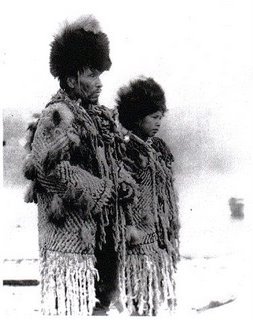Indigenous peoples in Canada
Indigenous Peoples in Canada refers to the first inhabitants of the land that is now Canada and their descendants. These groups are often divided into three categories: the First Nations, the Inuit, and the Métis. Each of these groups has distinct cultures, languages, histories, and spiritual beliefs. The history of Indigenous Peoples in Canada is marked by resilience and resistance in the face of colonization and policies aimed at assimilating them into European-Canadian culture, leading to ongoing social, economic, and political issues.
History[edit | edit source]
The history of Indigenous Peoples in Canada dates back thousands of years before the arrival of European settlers. Archaeological evidence suggests that Indigenous Peoples have inhabited what is now Canada for at least 12,000 years, with some evidence pointing to even earlier habitation.
With the arrival of Europeans in the 15th and 16th centuries, Indigenous Peoples faced drastic changes to their way of life. Initial contact often involved trade, particularly in furs, which led to the establishment of the fur trade. However, European colonization brought about land dispossession, introduction of diseases, and various forms of conflict and treaties.
The Indian Act of 1876 was a pivotal piece of legislation by the Canadian government that aimed to assimilate Indigenous Peoples into Canadian society. This act imposed governance structures, restricted movements, and introduced residential schools, among other impacts. The residential school system, in particular, had long-lasting effects on Indigenous communities, including loss of language and culture, and intergenerational trauma.
Culture[edit | edit source]
Indigenous cultures in Canada are diverse, with each nation having its own unique traditions, languages, and social structures. Traditional practices and beliefs are deeply rooted in a connection to the land, which is considered sacred. Indigenous art, including totem poles, beadwork, and paintings, plays a significant role in cultural expression and preservation.
Languages are an integral part of Indigenous cultures, with over 70 Indigenous languages reported in the 2016 Canadian census. Efforts are ongoing to revitalize and preserve these languages, many of which are endangered.
Contemporary Issues[edit | edit source]
Indigenous Peoples in Canada face a range of contemporary issues, including challenges related to health, education, employment, housing, and access to clean water. The legacies of colonization and residential schools continue to impact Indigenous communities.
Land rights and treaty rights remain contentious issues. Many Indigenous groups are involved in negotiations and legal battles with the Canadian government and corporations over land use, resource extraction, and sovereignty.
The Truth and Reconciliation Commission of Canada (TRC), established in 2008, aimed to document the history and lasting impacts of the Canadian Indian residential school system on Indigenous students and their families. It provided recommendations to address the legacy of residential schools and advance the process of Canadian reconciliation.
Rights and Recognition[edit | edit source]
The rights of Indigenous Peoples in Canada are recognized through various legal frameworks, including the Constitution Act, 1982, which acknowledges existing Aboriginal and treaty rights. In 2016, Canada announced its intention to fully adopt the United Nations Declaration on the Rights of Indigenous Peoples (UNDRIP), further affirming the rights of Indigenous Peoples to self-determination and equality.
Conclusion[edit | edit source]
The history and cultures of Indigenous Peoples in Canada are integral to the country's identity. Despite the challenges faced due to centuries of colonization and assimilation policies, Indigenous communities continue to fight for their rights, preserve their cultures, and contribute to Canadian society in significant ways.
Search WikiMD
Ad.Tired of being Overweight? Try W8MD's physician weight loss program.
Semaglutide (Ozempic / Wegovy and Tirzepatide (Mounjaro / Zepbound) available.
Advertise on WikiMD
|
WikiMD's Wellness Encyclopedia |
| Let Food Be Thy Medicine Medicine Thy Food - Hippocrates |
Translate this page: - East Asian
中文,
日本,
한국어,
South Asian
हिन्दी,
தமிழ்,
తెలుగు,
Urdu,
ಕನ್ನಡ,
Southeast Asian
Indonesian,
Vietnamese,
Thai,
မြန်မာဘာသာ,
বাংলা
European
español,
Deutsch,
français,
Greek,
português do Brasil,
polski,
română,
русский,
Nederlands,
norsk,
svenska,
suomi,
Italian
Middle Eastern & African
عربى,
Turkish,
Persian,
Hebrew,
Afrikaans,
isiZulu,
Kiswahili,
Other
Bulgarian,
Hungarian,
Czech,
Swedish,
മലയാളം,
मराठी,
ਪੰਜਾਬੀ,
ગુજરાતી,
Portuguese,
Ukrainian
Medical Disclaimer: WikiMD is not a substitute for professional medical advice. The information on WikiMD is provided as an information resource only, may be incorrect, outdated or misleading, and is not to be used or relied on for any diagnostic or treatment purposes. Please consult your health care provider before making any healthcare decisions or for guidance about a specific medical condition. WikiMD expressly disclaims responsibility, and shall have no liability, for any damages, loss, injury, or liability whatsoever suffered as a result of your reliance on the information contained in this site. By visiting this site you agree to the foregoing terms and conditions, which may from time to time be changed or supplemented by WikiMD. If you do not agree to the foregoing terms and conditions, you should not enter or use this site. See full disclaimer.
Credits:Most images are courtesy of Wikimedia commons, and templates, categories Wikipedia, licensed under CC BY SA or similar.
Contributors: Prab R. Tumpati, MD






